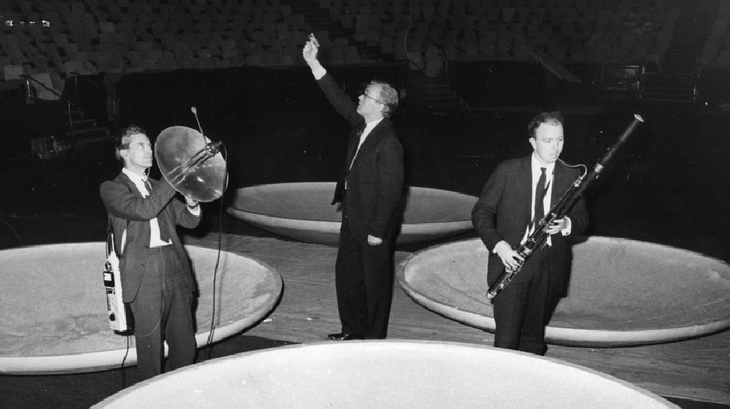
One of the most memorable components of the famously elliptical Royal Albert Hall is the delicate-looking glass dome. Dainty? It's a bruiser. The ribs, glazing and ceiling weigh 800 tons and, just to add extra 'yerk', they're not in any way fixed to the rest of the building. They just sit on the walls, staying put by sheer weight.
It’s not worth worrying about. The roof has squatted on those bricks since 1870 and was thoroughly tested before installation. Structural designers Ordish and Grover assembled the entire structure at Fairburn Engineering works in Manchester, to make sure everything fitted, before dismantling it and taking it down to London.

The truly nail-biting day came late in 1870. The roof was in place, but needed one final, delicate tweak. The entire site was evacuated, save for a few brave volunteers who stayed to gently knock-out the scaffolding support wedges so the roof could slump onto the walls. To general relief it shifted just half an inch and for the normally precision-crazy Victorian engineers, it was close enough.


Mr Gladstone, the prime minister, was informed and the entire project declared a triumph. It looked glorious — a wonderful daylight-filled lantern that flooded the hall with natural sunshine.
The same roof is in place to this day, with some notable refinements. The hall, though an engineering success, was an acoustic disaster. Everything looked great, but the sound was a horrible, echoing mess. The sunlight, though lovely, created such a glare people couldn't see the performers.

The first answer was a thick fabric 'velarium' (blind) hung across the roof. It didn't work and was finally removed after it had accumulated a literal ton of dust. In 1948 a fluted, aluminium skin was installed. That wasn't much cop either but it's still in there and at least cuts out the light.

After a lot of argy-bargy and complaints about aesthetics a solution was found in the famous/notorious 'mushrooms.' Oddly the very domes complained about by prommers in 1968/9 are now some of the hall's unique selling points.

For a health and safety manager, Guy Pengelly has a healthy attitude to risk — he respects heights, but once, with his professional hard-hat on, he knows something is safe, he'll take great delight in scaring the pants off anyone venturing up to the vast, secret world of the Royal Albert Hall's roof.

"I was blessed by the Dalai Lama in this lift," he announces inside a service elevator up to the top floor of the auditorium, AKA 'the Gods'. "At least I think that's why he held my hand. Most people hold on to it because they're scared."
Useful as they might be, elevators run out at that level. From there on it's stairs, then ladders, then walkways, then nothing. The now-customary maze of corridors eventually leads to a series of locked doors and finally, a curtain wall that, on the outside, houses the famous mosaic frieze depicting the Arts. Inside, a wide, flat roof covering the Gods is walkable, though just that tad too low for short people to see the 360⁰ view.

No matter, as the next section is a straight ladder leading up the inner brick wall, into the glass roof space. Gigantic iron ribs, painted white, smack of the Crystal Palace, a reference, perhaps, to the 1851 Great Exhibition that paid for the entire cultural quarter around Kensington, even if it didn't quite pay for the Royal Albert Hall.
On Albert's death, the distraught Victoria syphoned-off the money set aside for the Royal Albert Hall to pay for the Albert Memorial, just across the road. Unable to meet construction costs, the builders were forced to sell off the boxes; they are still in private ownership today. The queen refused to buy a box in what she considered her own hall, and by the time she finally capitulated, all the good ones had gone, which is why the Royal Box is still tucked away to one side.

The first thing that strikes us about the interior of the roof, the bit between the glass and the aluminium shell, is the sheer busy-ness of it all. Over a hundred motorised pulleys are permanently rigged in the roof, with a combined lifting capacity of 111.5 tonnes. In summer it can get unbearably hot — the thermometer regularly tops 38⁰C and 2006 saw 54⁰C, so the aluminium does help (a little) to insulate. It's also pretty – the fluting over the arena is now part of the hall’s design.

Aesthetics are not the only reason the jumble of pulleys are above the aluminium. A series of wooden step-ways allow (reasonably) easy access for technicians; the most substantial leads to the very tippy-top of the hall, the be-curtained 'Corona'.
Slipping through the blackout curtains, into the highest point of the auditorium, Pengelly treads out onto practically nothing. A grille was installed over the wheel-like, iron grid in 1948 and replaced in 2011 with a tensioned, wire version. It is, apparently, safer. It is also, basically, a trampoline. Pengelly jumps up and down to prove it's fine, but one glimpse through the mesh reveals a 43.5m drop to the middle of the arena floor and those mushrooms, far below, don't look like they'd do much to break a fall.

It's one hell of a view though. A terrifying, magical window into the zenith of Victorian engineering, a realisation of a 19th century vision: that all the arts, crafts and sciences are equally imperative to build a civilised society. Today, the Royal Albert Hall stays true to that vision with a complex programme that embraces everything from rock music to sport, space science to folk art. We'll take a regular seat downstairs, though, thanks…
Part 1 of the Secrets of the Royal Albert Hall explores the world beneath the floor.
All images © Sandra Lawrence, unless otherwise stated.



